The legless condition that is observed in several groups of extant
reptiles is the result of
A) their common ancestor having been
legless.
B) a shared adaptation to an arboreal (living in trees)
lifestyle.
C) several instances of the legless condition arising
independently of each other.
D) individual lizards adapting to a
fossorial (living in burrows) lifestyle during their
lifetimes
C
The scientific discipline concerned with naming organisms is
called
A) taxonomy.
B) cladistics.
C) binomial
nomenclature.
D) systematics.
E) phylocode
A
) The various taxonomic levels (viz, genera, classes, etc.) of the
hierarchical classification
system differ from each other on the
basis of
A) how widely the organisms assigned to each are
distributed throughout the
environment.
B) the body sizes of
the organisms assigned to each.
C) their inclusiveness.
D)
the relative genome sizes of the organisms assigned to each.
E)
morphological characters that are applicable to all organisms.
C
Which of these illustrates the correct representation of the binomial
scientific name for the
African lion?
A) Panthera
leo
B) panthera leo
C) Panthera leo
D) Panthera
Leo
E) Panthera leo
E
A phylogenetic tree that is ʺrootedʺ is one
A) that extends back
to the origin of life on Earth.
B) at whose base is located the
common ancestor of all taxa depicted on that tree.
C) that
illustrates the rampant gene swapping that occurred early in lifeʹs
history.
D) that indicates our uncertainty about the evolutionary
relationships of the taxa
depicted on the tree.
E) with very
few branch points.
B
The correct sequence, from the most to the least comprehensive, of
the taxonomic levels
listed here is
A) family, phylum,
class, kingdom, order, species, and genus.
B) kingdom, phylum,
class, order, family, genus, and species.
C) kingdom, phylum,
order, class, family, genus, and species.
D) phylum, kingdom,
order, class, species, family, and genus.
E) phylum, family,
class, order, kingdom, genus, and species.
B
The common housefly belongs to all of the following taxa. Assuming
you had access to
textbooks or other scientific literature,
knowing which of the following should provide you
with the most
specific information about the common housefly?
A) order
Diptera
B) family Muscidae
C) genus Musca
D) class
Hexapoda
E) phylum Arthropoda
C
If organisms A, B, and C belong to the same class but to different
orders and if organisms
D, E, and F belong to the same order but
to different families, which of the following pairs
of organisms
would be expected to show the greatest degree of structural
homology?
A) A and B
B) A and C
C) B and D
D) C
and F
E) D and F
E
Darwin analogized the effects of evolution as the above-ground
portion of a
many-branched tree, with extant species being the
tips of the twigs. The common ancestor
of two species is most
analogous to which anatomical tree part?
A) a single twig that
gets longer with time
B) a node where two twigs diverge
C) a
twig that branches with time
D) the trunk
E) neighboring
twigs attached to the same stem
B
Dozens of potato varieties exist, differing from each other in
potato-tuber size, skin color,
flesh color, and shape. One might
construct a classification of potatoes based on
these
morphological traits. Which of these criticisms of such a
classification scheme is most likely
to come from an adherent of
the phylocode method of classification?
A) Flesh color, rather
than skin color, is a valid trait to use for classification because it
is
less susceptible to change with the age of the tuber.
B)
Flower color is a better classification criterion, because
below-ground tubers can be
influenced by minerals in the soil as
much as by their genes.
C) A more useful classification would
codify potatoes based on the texture and flavor of
their flesh,
because this is what humans are concerned with.
D) The most
accurate phylogenetic code is that of Linnaeus. Classify potatoes
based on
Linnaean principles; not according to their
color.
E) The only biologically valid classification of potato
varieties is one that accurately
reflects their genetic and
evolutionary relatedness.
E
The term ʺhomoplasyʺ is most applicable to which of these
features?
A) the legless condition found in various types of
extant lizards
B) the 5-digit condition of human hands and bat
wings
C) the beta-hemoglobin genes of mice and of humans
D)
the fur that covers Australian moles and North American moles
E)
the basic skeletal features of dog forelimbs and cat forelimbs
A
If, someday, an archaean cell is discovered whose SSU-rRNA sequence
is more similar to
that of humans than the sequence of mouse
SSU-rRNA is to that of humans, the best
explanation for this
apparent discrepancy would be
A) homology.
B)
homoplasy.
C) common ancestry.
D) retro-evolution by
humans.
E) co-evolution of humans and that archaean.
B
) The best classification system is that which most closely
A)
unites organisms that possess similar morphologies.
B) conforms
to traditional, Linnaean taxonomic practices.
C) reflects
evolutionary history.
D) corroborates the classification scheme
in use at the time of Charles Darwin.
E) reflects the basic
separation of prokaryotes from eukaryotes.
C
Which of the following pairs are the best examples of homologous
structures?
A) bat wing and human hand
B) owl wing and
hornet wing
C) porcupine quill and cactus spine
D) bat
forelimb and bird wing
E) Australian mole and North American mole
A
) Some molecular data place the giant panda in the bear family
(Ursidae) but place the lesser
panda in the raccoon family
(Procyonidae). Consequently, the morphological similarities
of
these two species are probably due to
A) inheritance of
acquired characteristics.
B) sexual selection.
C)
inheritance of shared derived characters.
D) possession of
analogous structures.
E) possession of shared primitive characters.
D
In angiosperm plants, flower morphology can be very intricate. If a
tree, such as a New
Mexico locust, has flowers that share many
morphological intricacies with flowers of the
sweet pea vine,
then the most likely explanation for these floral similarities is the
same
general explanation for the similarities between the
A)
dorsal fins of sharks and of dolphins.
B) reduced eyes of
Australian moles and North American moles.
C) scales on moth
wings and the scales of fish skin.
D) cranial bones of humans and
those of chimpanzees.
E) adaptations for flight in birds and
adaptations for flight in bats.
D
The importance of computers and of computer software to modern
cladistics is most closely
linked to advances in
A) light
microscopy.
B) radiometric dating.
C) fossil discovery
techniques.
D) Linnaean classification.
E) molecular genetics.
E
) Which mutation should least require realignment of homologous
regions of a gene that is
common to several related
species?
A) 3-base insertion
B) 1-base substitution
C)
4-base insertion
D) 1-base deletion
E) 3-base deletion
B
The common ancestors of birds and mammals were very early (stem)
reptiles, which almost
certainly possessed 3-chambered hearts (2
atria, 1 ventricle). Birds and mammals, however,
are alike in
having 4-chambered hearts (2 atria, 2 ventricles). The 4-chambered
hearts of
birds and mammals are best described as
A)
structural homologies.
B) vestiges.
C) homoplasies.
D)
the result of shared ancestry.
E) molecular homologies.
C
Generally, within a lineage, the largest number of shared derived
characters should be
found among two organisms that are members
of the same
A) kingdom.
B) class.
C) domain.
D)
family.
E) order.
D
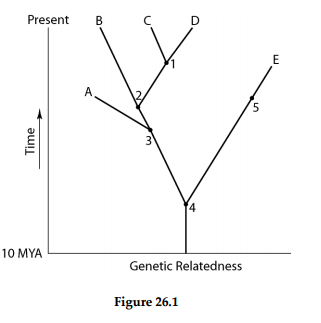
A common ancestor for both species C and E could be at position
number
A) 1.
B) 2.
C) 3.
D) 4.
E) 5.
D

The two extant species that are most closely related to each other
are
A) A and B.
B) B and C.
C) C and D.
D) D and
E.
E) E and A.
C

) Which species are extinct?
A) A and E
B) A and B
C)
C and D
D) D and E
E) cannot be determined from the
information provided
A

Which extinct species should be the best candidate to serve as the
outgroup for the clade
whose common ancestor occurs at position
2?
A) A
B) B
C) C
D) D
E) E
A
If this evolutionary tree is an accurate depiction of relatedness,
then which of the following
should be correct?
1. The entire
tree is based on maximum parsimony.
2. If all species depicted
here make up a taxon, this taxon is monophyletic.
3. The last
common ancestor of species B and C occurred more recently than the
last
common ancestor of species D and E.
4. Species A is the
direct ancestor of both species B and species C.
5. The species
present at position 3 is ancestral to C, D, and E.
A) 2 and
5
B) 1 and 3
C) 3 and 4
D) 2, 3, and 4
E) 1, 2,
and 3
E
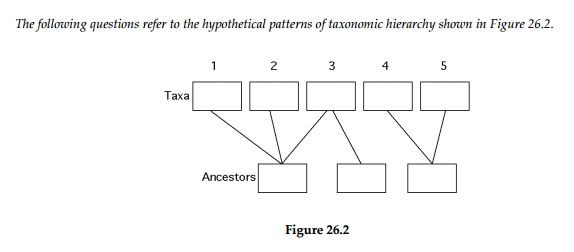
Which of the following numbers represents a polyphyletic
taxon?
A) 2
B) 3
C) 4
D) 5
E) more than one
of these
B

) If this figure is an accurate depiction of relatedness, then which
taxon is unacceptable,
based on cladistics?
A) 1
B)
2
C) 3
D) 4
E) 5
C
) Which of the following is not true of all horizontally oriented
phylogenetic trees, where
time advances to the right?
A)
Each branch point represents a point in absolute time.
B)
Organisms represented at the base of such trees are ancestral to those
represented at
higher levels.
C) The more branch points that
occur between two taxa, the more divergent their DNA
sequences
should be.
D) The common ancestor represented by the rightmost
branch point existed more
recently in time than the common
ancestors represented at branch points located to
the
left.
E) The more branch points there are, the more taxa are
likely to be represented.
A
Ultimately, which of these serves as the basis for both the principle
of maximum parsimony
and the principle that shared complexity
indicates homology rather than analogy?
A) the laws of
thermodynamics
B) Boyleʹs law
C) the laws of
probability
D) chaos theory
E) Hutchinsonʹs law
C
) Shared derived characters are most likely to be found in taxa that
are
A) paraphyletic.
B) polyphyletic.
C) monophyletic.
C
A taxon, all of whose members have the same common ancestor,
is
A) paraphyletic.
B) polyphyletic.
C) monophyletic.
C
The term that is most appropriately associated with clade is
A)
paraphyletic.
B) polyphyletic.
C) monophyletic.
C
If birds are excluded from the class Reptilia, the term that
consequently describes the class
Reptilia is
A)
paraphyletic.
B) polyphyletic.
C) monophyletic.
A
If the eukaryotic condition arose, independently, several different
times during
evolutionary history, and if ancestors of these
different lineages are extant and are classified
in the domain
Eukarya, then the domain Eukarya would be
A)
paraphyletic.
B) polyphyletic.
C) monophyletic.
B
When using a cladistic approach to systematics, which of the
following is considered most
important for
classification?
A) shared primitive characters
B) analogous
primitive characters
C) shared derived characters
D) the
number of homoplasies
E) overall phenotypic similarity
C
The four-chambered hearts of birds and the four-chambered hearts of
mammals evolved
independently of each other. If one were unaware
of this independence, then one might
logically conclude
that
A) the birds were the first to evolve a 4-chambered
heart.
B) birds and mammals are more distantly related than is
actually the case.
C) early mammals possessed feathers.
D)
the common ancestor of birds and mammals had a four-chambered
heart.
E) birds and mammals should be placed in the same family.
D
Phylogenetic hypotheses (such as those represented by phylogenetic
trees) are strongest
when
A) they are based on amino acid
sequences from homologous proteins, as long as the
genes that
code for such proteins contain no introns.
B) each clade is
defined by a single derived character.
C) they are supported by
more than one kind of evidence, such as when fossil
evidence
corroborates molecular evidence.
D) they are
accepted by the foremost authorities in the field, especially if they
have won
Nobel Prizes.
E) they are based on a single DNA
sequence that seems to be a shared derived sequence.
C
Cladograms (a type of phylogenetic tree) constructed from evidence
from molecular
systematics are based on similarities in
A)
morphology.
B) the pattern of embryological development.
C)
biochemical pathways.
D) habitat and lifestyle choices.
E)
mutations to homologous genes
E
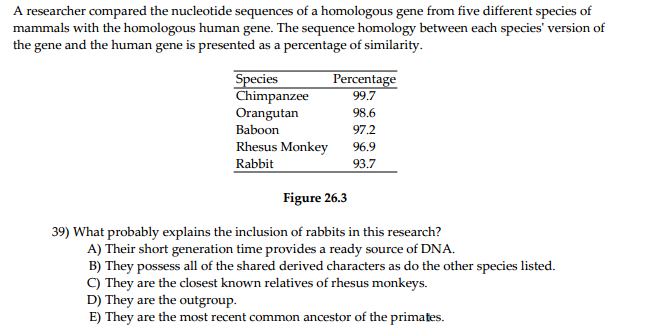
D
Based on the tabular data, and assuming that time advances
vertically, which cladogram (a
type of phylogenetic tree) is the
most likely depiction of the evolutionary relationships
among
these five species?
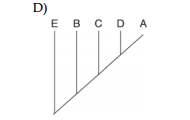
Regarding these sequence homology data, the principle of maximum
parsimony would be
applicable in
A) distinguishing introns
from exons.
B) determining degree of sequence homology.
C)
selecting appropriate genes for comparison among species.
D)
inferring evolutionary relatedness from the number of sequence differences.
D
Which process hinders clarification of the deepest branchings in a
phylogenetic tree that
depicts the origins of the three
domains?
A) binary fission
B) mitosis
C)
meiosis
D) horizontal gene transfer
E) gene duplication
D
What kind of evidence has recently made it necessary to assign the
prokaryotes to either of
two different domains, rather than
assigning all prokaryotes to the same kingdom?
A)
molecular
B) behavioral
C) nutritional
D)
anatomical
E) ecological
A
What important criterion was used in the late 1960s to distinguish
between the three
multicellular eukaryotic kingdoms of the
five-kingdom classification system?
A) the number of cells
present in individual organisms
B) the geological stratum in
which fossils first appear
C) the nutritional modes they
employ
D) the biogeographic province where each first
appears
E) the features of their embryos
C
Which is an obsolete kingdom that includes prokaryotic
organisms?
A) Plantae
B) Fungi
C) Animalia
D)
Protista
E) Monera
E
Members of which kingdom have cell walls and are all
heterotrophic?
A) Plantae
B) Fungi
C) Animalia
D)
Protista
E) Monera
B
) Which kingdom has been replaced with two domains?
A)
Plantae
B) Fungi
C) Animalia
D) Protista
E) Monera
E
Which eukaryotic kingdom is polyphyletic and therefore not
acceptable, based on
cladistics?
A) Plantae
B)
Fungi
C) Animalia
D) Protista
E) Monera
D
Which eukaryotic kingdom includes members that are the result of
endosymbioses that
included an ancient proteobacterium and an
ancient cyanobacterium?
A) Plantae
B) Fungi
C)
Animalia
D) Protista
E) Monera
A
The human nuclear genome includes hundreds of genes that are
orthologs of bacterial
genes, and hundreds of other genes that
are orthologs of archaean genes. This finding can
be explained by
proposing that
A) neither archaea nor bacteria contain paralogous
genes.
B) the eukaryotic lineage leading to humans involved at
least one fusion of an ancient
bacterium with an ancient
archaean.
C) the infection of humans by bacteriophage introduced
prokaryotic genes into the
human genome.
D) horizontal gene
transfer did not occur to any significant extent among the
prokaryotic
ancestors of humans.
B
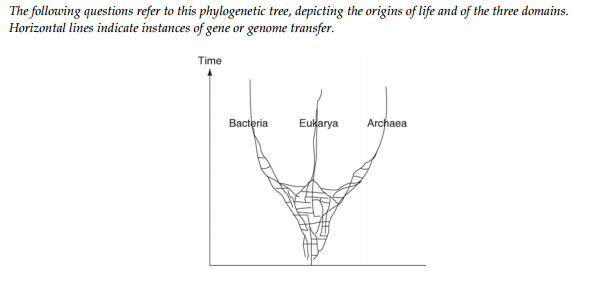
) If the early history of life on Earth is accurately depicted by
this phylogenetic tree, then
which statement is least in
agreement with the hypothesis proposed by this tree?
A) The last
universal common ancestor of all extant species is better described as
a
community of organisms, rather than an individual
species.
B) The origin of the three domains appears as a
polytomy.
C) Archaean genomes should contain genes that
originated in bacteria, and vice versa.
D) Eukaryotes are more
closely related to archaeans than to bacteria.
D

Which process is observed in prokaryotes and is responsible for the
vertical components of
the various bacterial and archaean
lineages?
A) mitosis
B) meiosis
C) sexual
reproduction
D) binary fission
D

Which of these processes can be included among those responsible for
the horizontal
components of this phylogeny?
A)
endosymbiosis
B) mitosis
C) binary fission
D) point
mutations
E) S phase of the cell cycle
A

Which portion of this tree may ultimately be better depicted as a
ʺringʺ?
A) the bacterial lineage
B) the archaean
lineage
C) the eukaryotic lineage
D) the weblike part near
the base of the tree
E) the part corresponding to the first
living cell on Earth
D

A large proportion of archaeans are ʺextremophiles,ʺ so called
because they inhabit extreme
environments with high acidity
and/or high temperature. Such environments are thought
to have
been much more common on the primitive Earth. Thus, modern
extremophiles
survive only in places that their ancestors became
adapted to long ago. Which of these is,
consequently, a valid
statement about modern extremophiles, assuming that their
habitats
have remained relatively unchanged?
A) Among
themselves, they should share relatively few ancestral traits,
especially those
that enabled ancestral forms to adapt to extreme
conditions.
B) On a phylogenetic tree whose branch lengths are
proportional to amount of genetic
change, the branches of the
extremophiles should be shorter, relative to branches of
the
non-extremophilic archaeans.
C) They should contain genes that
originated in eukaryotes that are the hosts for
numerous species
of bacteria.
D) They should currently be undergoing a high level
of horizontal gene transfer with
non-extremophilic archaeans.
B
In Figure 26.4 from your textbook, which similarly inclusive taxon
descended from the
same common ancestor as Canidae?
A)
Felidae
B) Mustelidae
C) Carnivora
D) Canis
E) Lutra
B
Three living species X, Y, and Z share a common ancestor T, as do
extinct species U and V.
A grouping that includes species T, X,
Y, and Z makes up
A) a valid taxon.
B) a monophyletic
clade.
C) an ingroup, with species U as the outgroup.
D) a
paraphyletic grouping.
E) a polyphyletic grouping.
D
In a comparison of birds with mammals, having four appendages
is
A) a shared ancestral character.
B) a shared derived
character.
C) a character useful for distinguishing birds from
mammals.
D) an example of analogy rather than homology.
E) a
character useful for sorting bird species.
A
If you were using cladistics to build a phylogenetic tree of cats,
which of the following
would be the best outgroup?
A)
lion
B) domestic cat
C) wolf
D) leopard
E) tiger
C
The relative lengths of the amphibian and mouse branches in the
phylogeny in Figure 26.12
in your textbook indicate that
A)
amphibians evolved before mice.
B) mice evolved before
amphibians.
C) the genes of amphibians and mice have only
coincidental homoplasies.
D) the homologous gene has evolved more
slowly in mice.
E) the homologous gene has evolved more rapidly
in mice.
D

D
To apply parsimony to constructing a phylogenetic tree,
A)
choose the tree that assumes all evolutionary changes are equally
probable.
B) choose the tree in which the branch points are based
on as many shared derived
characters as possible.
C) base
phylogenetic trees only on the fossil record, as this provides the
simplest
explanation for evolution.
D) choose the tree that
represents the fewest evolutionary changes, either in
DNA
sequences or morphology.
E) choose the tree with the
fewest branch points.
D